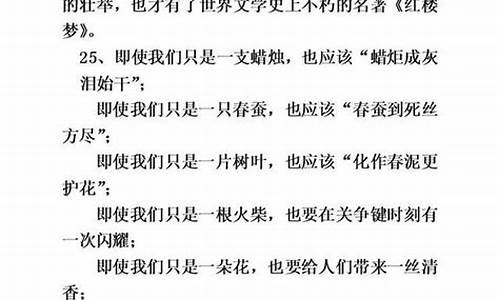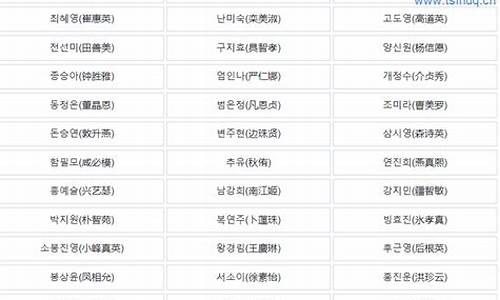您现在的位置是: 首页 > 名人语录 名人语录
英语句子结构例题_英语句子结构的题
tamoadmin 2024-08-10 人已围观
简介1.题目 英语的句子结构有哪几种2.主谓,主谓宾,主系表,结构的英语句子没种十句,简单点的来.3.可悬赏5到10分(英语)什么是句子结构,都有什么结构,怎么判断。谢谢。4.英语有哪几种句子结构?5.英语句子结构分析?6.谁能给我写出10个英语主系表结构的句子1 I live in the city主语+谓语+状语2 She will fly to beijing主语+谓语+状语3 Father b
1.题目 英语的句子结构有哪几种
2.主谓,主谓宾,主系表,结构的英语句子没种十句,简单点的来.
3.可悬赏5到10分(英语)什么是句子结构,都有什么结构,怎么判断。谢谢。
4.英语有哪几种句子结构?
5.英语句子结构分析?
6.谁能给我写出10个英语主系表结构的句子

1 I live in the city
主语+谓语+状语
2 She will fly to beijing
主语+谓语+状语
3 Father bought a bike
主语+谓语+宾语
4 My job is to help you
主语+系动词+表语
5 I am an english teacher
主语+系动词+表语
简单基本的句子成分
1.主语+谓语
2.主语+谓语+状语
3.主语+谓语+宾语
4.主语+系动词+表语
5.主语+谓语+间接宾语+直接宾语
6.主语+谓语+直接宾语+间接宾语
7.主语+谓语+宾语+宾语补足语
题目 英语的句子结构有哪几种
英语语法看上去很复杂,很多句型要记,但其实只要深入研究,就会发现其实也不过是围绕这五个基本句子来展开,分别是:
S十V主谓结构?
S十V十p主系表结构?
S十V十O主谓宾结构?
S十V十O1十O2 主谓双宾结构?
S十V十O十C 主谓宾补结构?
说明:S=主语;V=谓语;P=表语;O=宾语;O1=间接宾语;O2=直接宾语;C=宾语补足语?
五个基本句式详细解释如下:?
1.S十V句式?
在此句式中,V是不及物动词,又叫自动词(vi.)。例如:?
He runs quickly.?
他跑得快。?
They listened carefully.?
他们听得很仔细。?
He suffered from cold and hunger.?
他挨冻受饿。?
China belongs to the third world country.?
中国属于第三世界国家。?
The gas has given out.?
煤气用完了。?
My ink has run out.?
我的钢笔水用完了。?
2.S十V十P句式?
在此句式中,V是系动词(link v.),常见的系动词有:look,seem,ear,sound,feel,taste,smell,grow,get,fall ill/asleep,stand/sit still,become,turn等。例如:?
He is older than he looks.?
他比看上去要老。?
He seen interested in the book.?
他似乎对这本书感兴趣。?
The story sounds interesting.?
这个故事听起来有趣。?
The desk feels hard.?
书桌摸起来很硬。?
The cake tastes nice.?
饼尝起来很香。?
The flowers smell sweet and nicc.?
花闻起来香甜。?
You he grown taller than before.?
你长得比以前高了。?
He has suddenly fallen ill.?
他突然病倒了。?
He stood quite still.?
他静静地站看。?
He becomes a teacher when he grew up.?
他长大后当了教师。?
He could never turn traitor to his country.?
他永远不会背叛他的祖国。?
注意:有些动词同时也是及物动词,可构成SVO句式,例如:?
He looked me up and down.?
他上下打量我。?
He reached his hand to feel the elephant.?
他伸出手来摸象。?
They are tasting the fish.?
他们在品尝鱼。?
They grow rice in their home town.?
他们在家乡种水稻。?
He‘s got a chair to sit on.?
他有椅子坐。?
Please turn the sentence into English.?
请把这个句于泽成英语。?
3.S十V十O句式?
在此句式中,V是及物动词(vt.),因此有宾语。例如:?
I saw a film yesterday.?
我昨天看了一部**。?
He you read the story?
你读过这个故事吗?
They found their home easily.?
他们很容易找到他们的家。?
They built a house last year.?
他们去年建了一所房子。?
They‘ve put up a factory in the village.?
他们在村里建了一座工厂。?
They he taken good care of the children.?
这些孩子他们照看得很好。?
You should look after your children well.?
你应该好好照看你的孩子。?
4.S十V十O1十O2句式?
在此句式中,V是带有双宾语的及物动词。常见的须带双宾语的动词有give,ask,bring,offer,send,pay,lend,show,tell,buy,get;rob,warn等。例如:?
He ge me a book/a book to me.?
他给我一本书。?
He brought me a pen/a pen to me.?
他带给我一枝钢笔。?
He offered me his seat/his seat to me.?
他把座位让给我。?
注意下边动词改写后介词的变化:?
Mother bought me a book/a book for me.?
妈妈给我买了一本书。?
He got me a chair/a chair for me.?
他给我弄了一把椅子。?
Please do me a for/a for for me.?
请帮我一下。?
He asked me a question/a question of me.?
他问我个问题。?
注意,下边动词只有一种说法:?
They robbed the old man of his money.?
他们抢了老人的钱。?
He‘s warned me of the danger.?
他警告我注意危险。?
The doctor has cured him of his disease.?
医生治好了他的病。?
We must rid the house of th erats.?
我们必须赶走屋里的老鼠。?
They deprived him of his right to speak.?
他们剥夺了他说话的权利。?
5.S十V十O十C句式?
在此句式中,V是有宾语补足语的及物动词。常带宾语补足语的词有形容词、副词、介词短语、名词、不定式、现在分词、过去分词。?
常见的可接宾语补足语的动词很多,哪些动词可接哪几种形式作宾补,须根据动词的惯用法而定,不能统而概论。请看下面的例子。?
They made the girl angry.?
他们使这个女孩生气了。?
They found her hy that day.?
他们发现那天她很高兴。?
I found him out.?
我发现他出去了。?
I saw him in.?
我见他在家。?
They saw a foot mark in the sand.?
他们发现沙地上有脚印。?
They named the boy Charlie.?
他们给这个男孩起名为查理。?
I saw him come in and go out.?
我见他进来又出去。?
They felt the car moving fast.?
他们感到汽车行驶得很快。?
I heard the glass broken just now.?
我刚才听到玻璃碎了。?
He found the doctor of study closed to him.?
他发现研究所的大门对他关闭了。
主谓,主谓宾,主系表,结构的英语句子没种十句,简单点的来.
一、英语语句基本结构分析:
(一)主谓宾结构:
1、主语:可以作主语的成分有名词(如boy),主格代词(如you),数词,动词不定式,动名词等.主语一般
在句首.注意名词单数形式常和冠词不分家!
eg: The boy comes from America.
He made a speech.
2、谓语:谓语由动词构成,是英语时态、语态变化的主角,一般在主语之后.谓语可以是不及物动词(vi.)没
有宾语,形成主谓结构,
eg:We come.
Many changes took place in my home town.
注(以下这些词是不及物动词:表发生、出现的,如:take place, ear, hen, break out; 表来、去,如:com
e, go 等)
3、宾语:宾语位于及物动词之后,一般同主语构成一样,不同的是构成宾语的代词必须是‘代词宾格’,如:me,
him,them等.除了代词宾格可以作宾语外,名词,动名词,不定式等可以作宾语.
eg:I will do it tomorrow.
The boy needs a pen.
(二)主系表结构:
1、主语:同‘主谓宾’结构.
2、谓语:联系动词(Link verb):be动词(am,is,are,was,were,he been);其他联系动词如:become成为,turn变
成,go变和感官动词如:feel, touch, hear, see等.其特点是联系动词与其后的表语没有动宾关系,表语多为形容词
或副词,既,不可能是宾语.
3、表语:说明主语的状态、性质、等.可为形容词、副词、名词、代词、不定式、分词.(1)当联系动词不是
be,而其后是名词和代词时,多表达‘转变为’之意,注意与动宾关系的区别.
eg: He became a teacher at last.
His face turned red.
(2)感官动词多可用作联系动词
eg: He looks well.他面色好.
It sounds nice.这个听起来不错.
I feel good.我感觉好.
The egg smells bad.这个鸡蛋难闻.
例:Tom is a boy.(Tom是个男孩)主语为Tom,系词为be动词的第三人称单数is,表语为a boy
(三)There be 结构:
There be 表示‘存在有’.这里的there没有实际意义,不可与副词‘there那里’混淆.
此结构后跟名词,表示‘(存在)有某事物’
试比较:There is a boy there.(那儿有一个男孩.)/前一个there无实意,后一个there为副词‘那里’.
二、定语:定语是对名词或代词起修饰、限定作用的词、短语或句子,汉语中常用‘……的’表示.
定语通常位于被修饰的成分前.若修饰some,any,every,no构成的复合不定代词时,(如:something、nothing);
或不定式、分词短语作定语、从句作定语时,则定语通常置后.副词用作定语时须放在名词之后.
(一)形容词作定语:
The little boy needs a blue pen.小男孩需要一支蓝色的钢笔.
(二)数词作定语相当于形容词:
Two boys need two pens.两个男孩需要两支钢笔.
(三)形容词性物主代词或名词所有格作定语:
His boy needs Tom's pen.他的男孩需要Tom的钢笔.
There are two boys of Toms there.那儿有Tom家的两个男孩.
(四)介词短语作定语:
The boy in the classroom needs a pen of yours.教室里的男孩需要你的一支钢笔.
The boy in blue is Tom.穿兰色衣服的孩子是汤姆.
There are two boys of 9,and three of 10.有两个9岁的,三个10岁的男孩.
(五)名词作定语:
The boy needs a ball pen.男孩需要一支圆珠笔.
副词作定语:
The boy there needs a pen.那儿的男孩需要一支钢笔.
不定式作定语:
The boy to write this letter needs a pen.写这封信的男孩需要一支钢笔.
(六)分词(短语)作定语:
The smiling boy needs a pen bought by his mother.那个微笑的男孩需要一支他妈妈买的钢笔.
(七)定语从句:
The boy who is reading needs a pen.那个在阅读的男孩需要一支钢笔.
三、状语:状语修饰动词、形容词、副词或全句,说明方式、因果、条件、时间、地点、让步、方向、程度、目
的等
状语在句子中的位置很灵活,常见情况为:通常在句子基本结构之后,强调时放在句首;修饰形容词或副词时,
通常位于被修饰的词之前;表示时间、地点、目的的状语一般位于句子两头,强调时放在句首,地点状语一般须
在时间状语之前;一些表示不确定时间(如:often)或程度(如:almost)的副词状语通常位于be动词、助动
词、情态动词之后,动词之前.
有时状语在句中的某个位置会引起歧义,应注意,如:The boy calls the girl in the classroom.一般理解成‘男孩喊教
室里的女孩‘(此时in the classroom为girl的定语),也可以理解为‘男孩在教室里喊女孩’(此时in the classroom为地
点状语),最好写作‘In the classroom,the boy calls the girl.'
(一)副词(短语)作状语:
The boy needs a pen very much.男孩非常需要一支钢笔.(程度状语)
The boy needs very much the pen bought by his mother.男孩非常需要他母亲买的那支钢笔.(宾语较长则状语前
置)
The boy needs a pen now./Now,the boy needs a pen./The boy,now,needs a pen./男孩现在需要一支钢笔.(时间状
语)
(二)介词短语作状语:
In the classroom,the boy needs a pen.在教室里,男孩需要一支钢笔.(地点状语)
Before his mother,Tom is always a boy.在母亲面前,汤姆总是一个男孩子.(条件状语)
On Sundays,there is no student in the classroom.星期天,教室里没有学生.(时间状语)
(三)分词(短语)作状语:
He sits there,asking for a pen.他坐在那儿要一支笔.(表示伴随状态)
Hing to finish his homework,the boy needs a pen.因为不得不完成作业,男孩需要一支笔.(原因状语)
(四)不定式作状语:
The boy needs a pen to do his homework.男孩需要一支笔写家庭作业.(目的状语)
(五)名词作状语:
Come this way!走这条路!(方向状语)
(六)状语从句:
时间状语从句,地点状语从句,原因状语从句,结果状语从句,目的状语从句,比较状语从句,让步状语从句,
条件状语从句
四、直接宾语和间接宾语:
(一)特殊的同源宾语现象: fight a fight , dream a dream , etc.
(二)有些及物动词可以有两个宾语,如:give给,pass递,bring带,show显示.这两个宾语通常一个指人,为
间接宾语;一个指物,为直接宾语.间接宾语一般位于直接宾语之前.
一般的顺序为:动词 + 间接宾语 + 直接宾语.
eg:Give me a cup of tea,please.
强调间接宾语顺序为:动词 + 直接宾语 + to + 间接宾语.eg:Show this house to Mr.Smith.Mr.
五、宾语补足语:位于宾语之后对宾语作出说明的成分.宾语与其补足语有逻辑上的主谓关系,它们一起构成复
合宾语.
(一)名词/代词宾格 + 名词
The war made him a soldier.战争使他成为一名战士.
(二)名词/代词宾格 + 形容词
New methods make the job easy.新方法使这项工作变得轻松.
(三)名词/代词宾格 + 介词短语
I often find him at work.我经常发现他在工作.
(四)名词/代词宾格 + 动词不定式
The teacher ask the students to close the windows.老师让学生们关上窗户.
(五)名词/代词宾格 + 分词
I saw a cat running acrothe road.我看见一只猫跑过了马路.
六、同位语:同位语是在名词或代词之后并列名词或代词对前者加以说明的成分,近乎于后置定语.如:
We students should study hard. (students是we的同位语,都是指同一批‘学生’)
We all are students. (all是we的同位语,都指同样的‘我们’)
七、独立成分:有时句子中会有一些与句子没有语法联系的成分,称为句子独立成分(注意:区别于分词独立结
构).
感叹词:oh,hello,aha,ah,等.肯定词yes否定词no称呼语:称呼人的用语.插入语:一些句中插入的 I think , I belie
ve,等.
如: The story,I think,has never come to the end./我相信,这个故事还远没结束.
情态词,表示说话人的语气(多作为修饰全句的状语):perhaps也许,maybe大概,acturely实际上,certainly当然,
等.
八、分词独立结构:分词作状语时其逻辑主语与句子的主语一致! 否则应有自己的逻辑主语,构成分词独立结
构.
例:错句:Studying hard,your score will go up.
正确:(1) Studying hard,you can make your score go up. 或 (2)If you study hard,your score will go up.
解析:错句中分词studying没有自带逻辑主语,则其逻辑主语就是句子的主语,既your score . 显然做study的应是
人,不应是your score(分数). 正确句(1)更正了句子的主语,使其与分词逻辑主语一致( 同为you );正确句(2)则使
用条件分句带出study的主语,(不过已经不是分词结构了).
分词独立结构常省略being,hing been.不过‘There being...’的场合不能省略.
如:
Game (being) over,he went home.
He stands there,book (being) in hand.
独立结构还可用with、without引导,作状语或定语.这种结构不但可以用分词,还可以用不定式、形容词、介词
短语、副词或名词等.
如:
With nothing to do,he fell asleep soon.无事可做,他很快就睡着了.
The teacher came in,with glasses on his nose.老师进来了,戴着一付眼镜.(注意,此句on his nose不可省略!)
可悬赏5到10分(英语)什么是句子结构,都有什么结构,怎么判断。谢谢。
主谓结构:
I win.我赢了.
He failed.他失败了.
The sun rises.太阳升起来了.
He came.他来了.
She left.她走了.
He laughed.他笑了.
She cryied.她哭了.
The car stopped.车停了.
The old man died.那位老人死了.
The baby is born.婴儿出生了.
主谓宾:
I love you.我喜欢你.
She rang me.她打电话给我.
I made a cake,我做了蛋糕.
He helped me.他帮了我.
She sings songs.她唱歌.
She bought a gift for me.她买礼物给我.
He had dinner.他吃晚饭.
He ge me a book.他给我一本书.
He teached me English.他教我英语.
He likes animals,他喜欢动物.
主系表结构:
She is kind.她很善良.
He is rude.他很粗鲁.
I feel tired.我累了.
She looked worried.她看起来很着急.
I am fine.我很好.
My hobby is reading,我的兴趣是阅读.
The baby is a boy.婴儿是个男孩.
The flowers smells good.花闻起来很香.
It tastes delicious.尝起来很美味.
Her face turned red.她的脸变红了.
英语有哪几种句子结构?
英语中有五大句子结构:
1)主系表结构(主语+联系动词,也叫 Be 动词+表语),例如:I am a student(我是个学生).
2)主谓结构(主语+谓语),例如:I work(我工作) I sleep(我睡觉).
3)主谓宾结构(主语+谓语+宾语),例如:I study English(我学习英语).
4)主谓双宾结构:(主语+谓语+2个宾语),例如:She ge me an le.(给我一个苹
果),其中 She 是主语,ge 是谓语,me 和 le 都是宾语,所以称作双宾语。双宾语可
以转换成:She ge an le to me.
5)主谓宾加宾补结构:(主语+谓语+宾语+宾语补足语),例如:I see a girl dancing.(我看见
一个女孩在跳舞),dancing(跳舞)是动名词做宾语补足与,与宾语有主谓关系。
英语句子结构分析?
英语句子看上去纷繁庞杂,但仔细观察不外乎五个基本句式。这五个基本句式在不同的时态、语态下,可以演变出多种复杂的英语句子,换言之,绝大多数英语句子都是由这五个基本句式生成的。这五个基本句式如下:S十V主谓结构; S十V十O主谓宾结构; S十V十F主系表结构; S十V十O1+ O2 主谓双宾结构;S十V十O十C 主谓宾补结构.说明:S=主语;V=谓语;P=表语;O=宾语;O1=间接宾语;O2=直接宾语;C=宾语补足语五个基本句式详细解释如下:1 .主谓型:S十V句式
在此句式中,V是不及物动词,又叫自动词(vi.)。例如:
He runs quickly.他跑得快。
They listened carefully.他们听得很仔细。
He suffered from cold and hunger.他挨冻受饿。
China belongs to the third world country.中国属于第三世界国家。
The gas has given out.煤气用完了。
My ink has run out.我的钢笔水用完了。2.主谓宾:S十V十O句式
在此句式中,V是及物动词(vt.),因此有宾语。例如:
I saw a film yesterday. 我昨天看了一部**。 He you read the story? 你读过这个故事吗?
They found their home easily. 他们很容易找到他们的家。They built a house last year. 他们去年建了一所房子。They've put up a factory in the village. 他们在村里建了一座工厂。
They he taken good care of the children. 这些孩子他们照看得很好。
You should look after your children well. 你应该好好照看你的孩子。3.主系表:S十V十P句式
在此句式中,V是系动词(link v.)常见的系动词有:(1):be-am/is/are/was/were (我用am你用are,is连着他、她、它);(2):感官动词:sound,look, smell,taste,feel;(3):变得---: get,turn ,become, grow等;(4):其它:go(bad/unpunished); fall (ill/asleep); stand/sit (still),remain(weak). seem,ear,等。例如:
He is older than he looks. 他比看上去要老。
He seems interested in the book. 他似乎对这本书感兴趣。
The story sounds interesting. 这个故事听起来有趣。
The desk feels hard. 书桌摸起来很硬。
The cake tastes nice. 饼干尝起来很香。
The flowers smell sweet and nice.花闻起来香甜。
You he grown taller than before.你长得比以前高了。
He has suddenly fallen ill. 他突然病倒了。
He stood quite still. 他静静地站看。
He becomes a teacher when he grew up.他长大后当了教师。
He could never turn traitor to his country.他永远不会背叛他的祖国。注意:有些动词同时也是及物动词,可构成SVO句式,例如:He looked me up and down.他上下打量我。
They are tasting the fish.他们在品尝鱼。
They grow rice in their home town.他们在家乡种水稻。
He's got a chair to sit on.他有椅子坐。
Please turn the sentence into English.请把这个句子译成英语。4.动词加双宾: S十V十O1十O2句式
在此句式中,V是带有双宾语(间接宾语/直接宾语)的及物动词。常见的须带双宾语的动词有give,ask,bring,offer,send,pay,lend,show,tell,buy,get;rob,warn等。例如:He ge me(间接宾语)a book(直接宾语)/a book to me.他给我一本书。
He brought me a pen/a pen to me. 他带给我一枝钢笔。
He offered me his seat/his seat to me. 他把座位让给我。注意下边动词改写后介词的变化:
Mother bought me a book/a book for me. 妈妈给我买了一本书。
He got me a chair/a chair for me. 他给我弄了一把椅子。
Please do me a for/a for for me. 请帮我一下。He drew a picture for me. 他画张画给我
He asked me a question/a question of me.他问我一个问题。
注意,下边动词只有一种说法:
They robbed the old man of his money. 他们抢了老人的钱。
He's warned me of the danger. 他警告我注意危险。
The doctor has cured him of his disease. 医生治好了他的病。
We must rid the house of the rats. 我们必须赶走屋里的老鼠。
5. 宾语补语: S十V十O十C句式
在此句式中,V是有宾语补足语的及物动词,如: see; hear; hear; he; let; consider; ask; tell; advise等。 常带宾语补足语的词有形容词、副词、介词短语、名词、不定式、现在分词、过去分词;常见的可接宾语补足语的动词很多,哪些动词可接哪几种形式作宾补,
须根据动词的惯用法而定,不能一概而论,请看下面的例子。They made the girl angry.他们使这个女孩生气了。
They found her hy that day.他们发现那天她很高兴。
I found him out.我发现他出去了。
I saw him in.我见他在家。
They saw a footprint in the sand.他们发现沙地上有脚印。
They named the boy Charlie.他们给这个男孩起名查理。
I saw him come in and go out.我见他进来又出去。
They felt the car moving fast.他们感到汽车行驶得很快。
I heard the glass broken just now.我刚才听到玻璃碎了。
He found the door of study closed to him.他发现研究所的大门对他关闭了。英语句子分为简单句、并列句和复合句单句结构要牢记,复句注意关、连词关连词分为关系词(关系代词或关系副词:Wh---/how---)和连词(并列连词(and/or/but)和其它连词because/although/as if/so/however/weather/if等。不管英语的复句多长、多复杂,去掉关、连词后,它还是简单句结构!
谁能给我写出10个英语主系表结构的句子
此句为简单句,I为主语,am not used to为谓语,being spoken to like that为状语。
英语句子分为简单句、复合句和复杂句。此句显然为简单句,其中没有表示复合句和复杂句的连接词。在英语中,be?(not) used to + (verb-ing)是固定搭配,意思是“(不)习惯于”。
I am not used to being spoken to like that. 整句话的意思就是“我不习惯于像那样对人说话(与人交流)”。
扩展资料
现在完成进行时
1、概念:表示从过去某一时间开始一直延续到现在的动作。这一动作可能刚刚开始,也可能仍在继续,并 可能延续到将来。
2、基本结构:主语 + he/has + been + doing + 其它
3、时间状语:since + 时间点,for + 时间段等。
4、例子:
I he been sitting here for an hour.
我已经在这里坐了一个小时。
The children he been watching TV since six o'clock.
从6点起,孩子们一直看电视。
牛津词典:英语语法
10个英语主系表结构的句子如下:
1、The day is long and the night is short in winter.
冬天昼长夜短。
2、He is out of work.
他失业了。
3、The page has been yellow.
这一页是**的。
4、Childen,be quiet please.
小朋友,请保持安静。
5、This madom looks very healthy.
这位女士看起来很健康。
6、The report sounds very interesting.
这个报告听起来很有趣。
7、To understand A and B is essential.
理解A和B是必要的。
8、This kind of food tastes delicious.
这种食物吃起来很可口。
9、He looked worried just now.
刚才他看上去有些焦急。
10、Springcomes. It is getting warmer and warmer.
春天到了,天气变得越暖和。
下一篇:惜时名句的来源和含义_惜时名句









